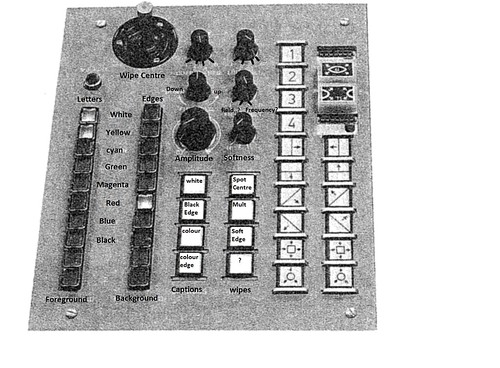
However, to call it a video switcher is misleading. It does more than your average video switcher, and that is why it is referred to as a "mixer." Just looking at it can tell you why that is. This "mixer" has the unique quality of being able to switch or mix up to 8 sources at one time. Rather, it has two modes- switching and mixing. Like any 8-source switcher, there are two banks of inputs, with switches to select what is present on that bus. The two banks can then be switched or wiped based on a special effects panel. Pretty standard for a switcher. The only neat thing in this section is that there are pluggable units for the effects section that expand the available wipe effects up to 106. Still, pretty standard.

The effects panel of the ep5/512, showing pluggable wipe units in upper right corner
The special features of this mixer appear when you start asking what the faders are above the selection switches. These actually form an additive mixing section for each bank. When the mixer is in switching mode the faders are inactive. However, when a fader is topped (brought to its highest position), the selection switch pops out and the bank is now controlled by the mixer section. Theoretically all eight channels could be combined in the image on the screen. The mixer has limiting circuitry built in to prevent the image from deviating from standard transmission line voltages. With this ability, very complex layered images can be created. Certainly with modern cascaded switchers, complex overlays can be done, but it would require multiple buses and effects bars sitting in their (I feel, unstable) middle position. Also, with a setup that takes up the same room as a single bus 16 input switcher.
To switch back to switching mode, press a selection switch and control is returned to those selectors. It's here where I get a little confused, because the fader can remain topped and selection can be changed over to the switches. It would be my guess that you would have to lower and top the fader again in order to regain control with the mixer. I have yet to find an operational manual for one of these mixers. All of the information that I have for this comes from an engineering manual and a (of all things) clip from a Blue Peter episode. The engineering manual was found on bbceng.info which is a marvelous site for learning about all of the tech that the BBC employed on a very small scale (I mean down to the individual modules that make up consoles and apparatus). Unfortunately, no instruction manuals...
The Blue peter episode, reproduced below, gives a neat look into the gallery (or control room if you prefer) of TC1. It's a neat little clip, but for just the mixer, skip to the 5 minute mark.
According to the manual, the switcher also had the ability to put black borders around white captions or to synthesize alternate colors on them. Also, the ability to remove color for keying. In the Blue Peter video, you can just barely make out "overlay" and "background" on the two rows of pushbutton switches above the faders. Most of the labels on these diagrams from the manual are illegible due to the angle they were taken from and the black and white scan of the manual. To get the images look better and to be able to read the labels, I blurred the images a bit. These are the images you see here. I had to toggle between the two to trick my eyes into seeing the labels. This is what I was able to make out from the effects panel (click for a larger image:

It seems that the rows of knobs go in line with the rows of switches, so despite not being able to see their labels, I figure the knob above amplitude is a positioning knob for the captions and then some other knob that seems labelled 1,2,4 and 8). Softness is a switch I figure- "four degrees of hardness" the manual states. The rest, I have not much of a clue. The top right seems to start with "limit" but I doubt that its the control for the mixer's limiter. It's really interesting to figure though, that the mixer has such comprehensive controls for something kind of almost trivial- caption coloring. The wipes are quite neat though, and this view gives a great view of the pluggable modules. There are none installed on the Blue Peter program. Oddly enough, in this diagram, the color selected is light yellow text with a red edge.
UK TV studio History has some neat stories about this mixer, but not too much. As a matter of fact, there's not much out there at all for this mixer. It's weird though, because it was a very long lasting mixer, surviving from the dawn of color almost to the end of the EMI 2001 (although was most likely phased out sooner in the mid 80s)

This mixer-type was still in use in TC6, 7 and 8 at TV Centre in 1990, when I was a trainee vision mixer there.
ReplyDelete